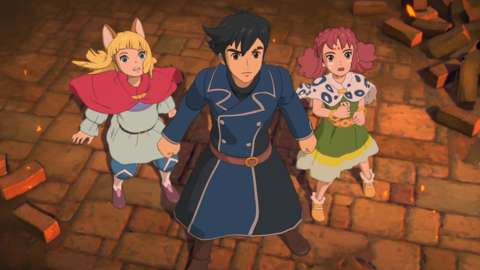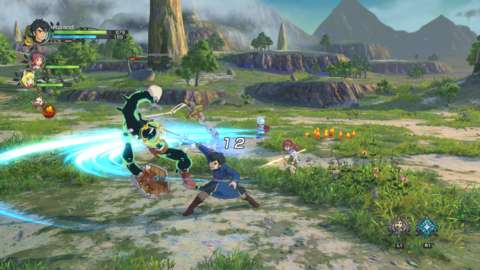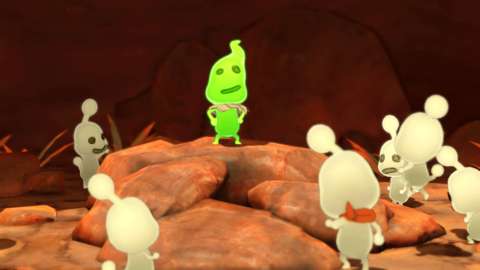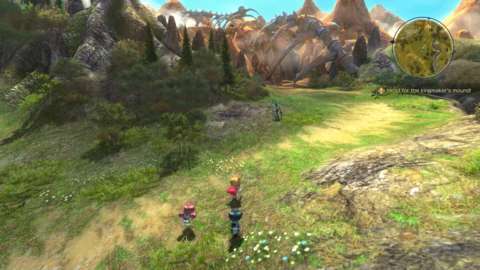Before Ni no Kuni: Wrath of the White Witch was released in 2012, Level-5 CEO Akihiro Hino wanted to see how the game performed outside of Japan before committing to the production of a sequel. It was an enhanced remake of an existing Japan-only RPG made in collaboration the Studio Ghibli animation house, containing elements of Japanese culture the company wasn't sure would come through completely in its English localization.
But, Wrath of the White Witch was considered a huge success. It sold 1.9 million copies worldwide, was critically acclaimed, and now Level-5 is in the process of developing its sequel, Ni no Kuni 2: Revenant Kingdom, for PS4 and PC. GameSpot recently travelled to the Bandai Namco offices in Japan to observe a hands-off demonstration of the game, and speak directly to Akihiro Hino.
Fallout 4 Next Gen Update Comparison Stellar Blade - 13 Things I Wish I Knew S.T.A.L.K.E.R. 2: Heart of Chornobyl — Official "Not a Paradise" Trailer Sea of Thieves Season 12: Official Content Update Video Manor Lords - Official Medieval City Builder/RTS Launch Trailer Devil May Cry: Peak Of Combat | Dante: Blazing Tempest Gameplay Trailer ALIEN: Rogue Incursion - Announcement Teaser Trailer Honkai: Star Rail - "Then Wake to Weep" | Version 2.2 Trailer SAND LAND — Official Launch Trailer Stellar Blade - Hard Mode No Damage Gigas Boss Gameplay Stellar Blade - Hard Mode No Damage Abaddon Boss Gameplay Stellar Blade - (Almost) All Outfits
Please enter your date of birth to view this video
By clicking 'enter', you agree to GameSpot's
Terms of Use and Privacy Policy
"Ni no Kuni was such a huge hit, especially in Western countries, and Level-5 really felt the affection," Hino told GameSpot through an interpreter. "Even I was surprised to have so many fans, so that was the main reason for a sequel."
This time around, Level-5 has had its sights set on international audiences from the beginning. The company is planning to release Ni no Kuni 2 worldwide at the same time, and more significantly, will have a PC (Steam) version. Hino explained: "We really care about having a worldwide sensibility this time around. In the first game we had a character doing Manzai [Japanese-style stand-up comedy] for example, but since this game will also be released at the same time for Japanese and Western audiences, from a localisation point of view we're really making it as straightforward as possible for players of all cultures to understand."
We're really making it as straightforward as possible for players of all cultures to understand.
Even though Level-5 isn't collaborating directly with Studio Ghibli for Revenant Kingdom, the Ghibli style is still very clear and present in many facets. Former Ghibli animator Yoshiyuki Momose and composer Joe Hisaishi are involved in project, so it still looks and sounds like a Ghibli project. But the team is also continuing to extend this style to Ni no Kuni 2's story and characters. The game focuses on the androgynous Evan, a shy and reluctant young king whose perceived weakness inevitably leads to a coup and the death of his mother. These events lead him to encounter an orphan-turned-Sky Pirate leader named Tani, and Roland, a middle-aged president of a major country in the real world who mysteriously finds himself in Evan's kingdom.

"Ghibli films mostly deal with families, and ever since we teamed up with Ghibili in the previous games I really wanted to focus on the bonds of family," Hino said. "That's what we want to illustrate with the Ni no Kuni series. The first game was about the bond between mother and son, and this time--although they're not a real family--Roland and Evan, there's an age difference between them. We wanted to show a virtual or foster relationship between them. There are sometimes love stories in Ni no Kuni, but that's less of a priority. The main theme we want to emphasise are family bonds."
The gameplay demo we were shown began with Evan, Roland, and Tani on the overworld map, referred to as the "Field Map" by Hino. The characters were portrayed in a "chibi" or "daruma" style, with enlarged heads, eyes, and tiny bodies. Here, the perspective was high above the characters, allowing for grand views of the landscape. The reason for this, Hino said, was because Ni no Kuni 2 would feature a "Kingdom Builder" mechanic later in the game, and it would utilise the Field Map view.
The main theme we want to emphasise are family bonds.
Like the first Ni no Kuni, and as is becoming commonplace in RPGs, hostile monsters are visible from the Field Map, so it's possible to avoid combat encounters. Engaging in combat on the Field Map causes a transition into a ground-level battle screen, where characters are of a more realistic proportion. Combat in Revenant Kingdom seemed more streamlined than the original game, at least at this early stage. Fights take place in real-time, and players control Evan's movements and attacks directly. The player can also switch to other members of the party, while characters not under direct control behave autonomously. Using other party members brings the advantages of different weapons and skillsets. Roland utilized a sword and a modern-looking pistol, and Tani was armed with a bow and spear. Some enemies, Hino said, would be more susceptible to damage from certain weapons.

R1 would bring up a shortcut menu for character-specific special skills, like a flurry of sword slashes, and L1 would bring up a shortcut menu for Ni no Kuni's new helper creatures called "Higgledies." Higgledies are tiny, elemental familiars that follow Evan around like Pikmin, and can be used to conjure spells like a fiery cyclone, a lightning storm, or a giant stone hammer. Up to four different types of Higgledies can be equipped at a time. As a whole, it's a battle system that's reminiscent of Final Fantasy XV, though less chaotic. Hino stated that he wanted combat to feel "stress-free, but exciting."
After a few combat encounters in the Field Map, Hino moved the party along into one of the game's early dungeon areas: a rocky, mountainous zone called "Cloudcoil Canyon." In dungeons, all exploration takes place from the same ground-level perspective as combat, meaning hostile encounters occur immediately once in the presence of enemies. The transition is seamless and almost imperceptible. Evan and the party casually pull out their weapons when approaching an enemy, without any overt fanfare. "The whole dungeon is the battlefield for the real-time system, "Hino said. The characters could run behind rocky outcroppings for a quick breather, and battles didn't seemed confined to one area--fights would gradually move further through the dungeon as time went on.
Some simple traversal puzzles were also shown. At one point in the dungeon, Evan and the party came across a high, unreachable ledge with a mini-tornado at its base. Overcoming this obstacle required further exploration of the dungeon in order to discover a new type of Higgledie--one that harnessed the elemental power of wind. With yet another cute familiar in tow, the party could then interact with the mini-tornado and use it to propel themselves up and onto the ledge.

The Higgledies themselves are another strong nod to the series' Ghibli roots. Their designs echo creatures like the Kodamas from Princess Mononoke, or Soot Sprites from My Neighbour Totoro. "We wanted to incorporate something similar to the Familiars in the last game, monsters to help the main characters out in battle," Hino later explained, although some fans of Wrath of the White Witch may be disappointed at the absence of the Familiar mechanic. Also absent was an endearing supernatural companion analogous to Drippy in Wrath of the White Witch, but Hino assured us not to worry on that front: "We can't give away too much at the moment, but there'll be a specific character which will be joining Evan, and he'll be a speaking character. To give you some clue, it's different from Drippy, but this character will have a great role in this game. It's more connected to the main story."
The demo finally culminated in a boss battle with a large yeti-like creature called "Thogg: The Wooly Bully." The Wooly Bully exhibited familiar attacks--charging across the battlefield, leaping high in the air, and causing shockwaves as it landed. Here, Hino showed off another strategic purpose for the Higgledies. By holding L1 and hitting "Up" on the D-Pad, players could command the Higgledies to attack Thogg en-masse, stunning the creature and holding him in place, restricting his movement. At this point, the characters could land and stack their special attacks easily.

As the demo ended, Hino also took a minute to emphasise--with a smile--a detail that he thought would be of great interest to Western audiences: although the development build we were seeing was running at 30 frames per second, the final would run at 60 frames per second, even on a standard PlayStation 4.
Hino seemed confident that Revenant Kingdom would resonate even further with Western audiences. "The technology is evolving, and having a PC version means the game is more accessible for everyone overseas. As a fan of Western RPGS, I think our games need to be offering a similarly great experience, utilising things like an open world and a stress-free battle system. It should feel familiar for all gamers."
"There are no more boundaries," Hino said. "We can't just define what makes a 'JRPG' anymore. Ni no Kuni is an 'RPG.'"
GameSpot travelled to Tokyo at the expense of Bandai Namco Entertainment.

